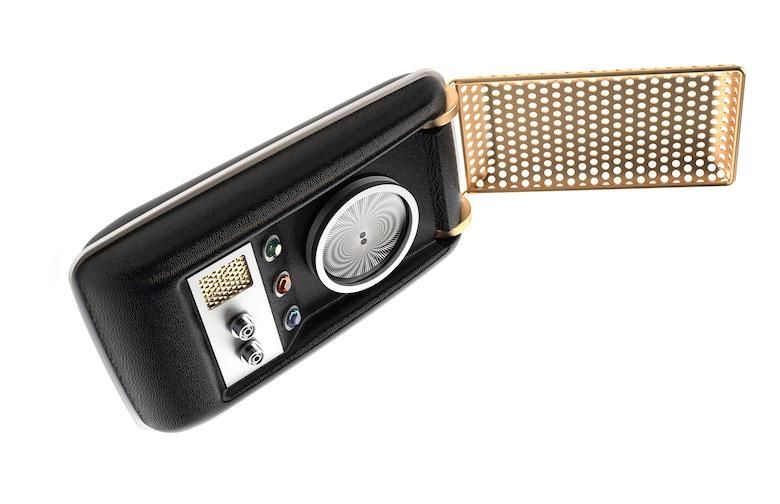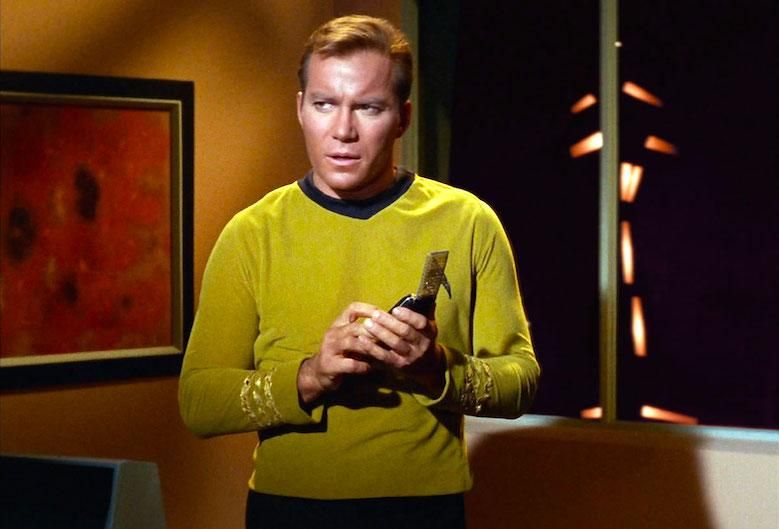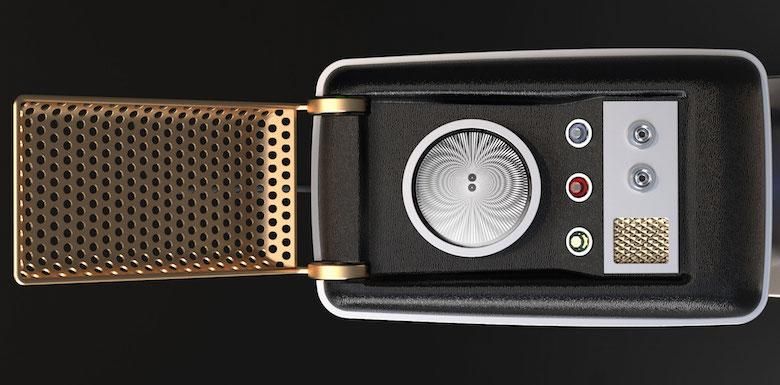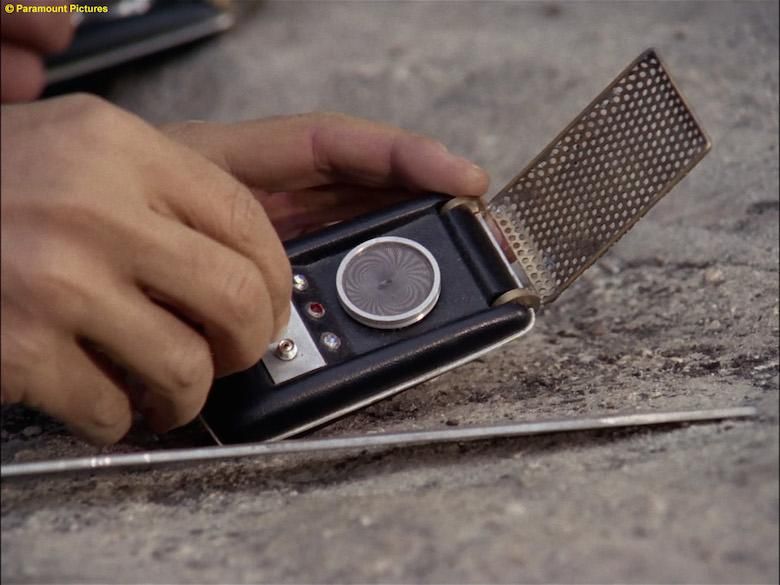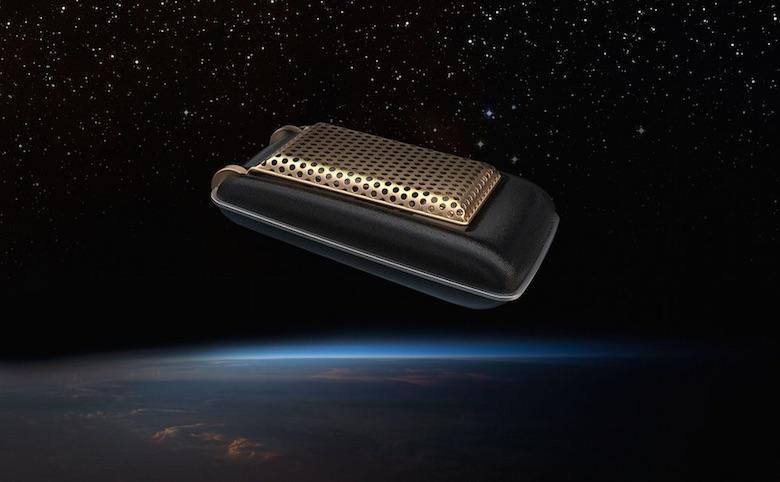By now you’ve seen the stories coming out of San Diego Comic Con featuring the new top contender for nerdiest phone gadget of 2015, the Wand Company’s Star Trek Bluetooth Communicator. Some folks close to the manufacturer have known about the project for months, while others attending SDCC are going hands-on with the prototype even as I type these words. Because I’m in neither of those groups, I’ve spent the afternoon sitting in a New York sidewalk cafe fruitlessly throwing money at my computer screen and waiting for it to cough up a communicator of my own.
I’m taking a break from that for a second, though. Because while I won’t have hands-on experience for a while, I do know an awful lot about Star Trek – and its futuristic communicator in particular. And one thing that everyone else reporting on this sucker seems to have missed is that it’s going to be much more than a toy. It’s likely to be a masterpiece.
What is a “Star Trek Bluetooth Communicator” anyway?
Assuming you have a basic familiarity with the most recognizable science-fiction series of all time (a crew of well-equipped explorers travels the galaxy in search of new life and new civilizations) we can cut right to the chase: the communicator is Star Trek‘s version of the mobile phone. In the original Star Trek‘s version, it’s a pocket-sized gadget with a flip-top cover that provides voice and data communications between a landing party and an orbiting starship. While later Trek series would condense the device into a wearable badge, this original version remains the most iconic manifestation of the show’s uncanny ability to predict the future – or at least inspire builders to mold the future to Trek‘s vision. By connecting wirelessly to the mobile phone in your pocket and allowing you to make and take calls through a very accurate approximation of Captain Kirk’s most-famous accessory, the Star Trek Bluetooth Communicator finally eliminates the gulf between the imaginary future of 1966 and the modern-day reality of 2015.
If you’re weighing the combination of a motivated fanbase with the ever-decreasing size and cost of modern electronics, you’re probably wondering why we haven’t seen something like this before. The truth is, we have.
It’s not the first of its kind
As we showed you a few years back in the April Fool’s video above, Bluetooth Communicators have been “a thing” for a while. As early as 2008, enterprising engineers were cramming wholesale Bluetooth speakerphones into the bodies of store-bought communicator replicas. The efforts ranged from the crude to the elaborate, with the best examples occasionally offered for sale via eBay or on Star Trek-centric message boards. The Communicator-as-phone subculture was helped along by occasional flashes of mainstream exposure like the MAKE do-it-yourself tutorial and the discovery that Nokia had built a prototype run of Symbian-powered Star Trek Communicators back in 2008 (one of which I bought in 2010).
But first isn’t always best
Those early efforts, as heartfelt and innovative as they sometimes were, were also prototypical in the extreme – as is evident above. My Nokia test unit featured, among other things, an impossible-to-press power button, a completely obscured external display, a broken charging port … and a secondhand price tag somewhere in used-car territory. (Full disclosure: I own the YouTube channel that hosts the above video.)
And while the Bluetooth communicator I had custom-made a couple years later was a big step up, it still brought a ton of compromises. To wit: a clunky mini USB port smack in the middle of the back cover, a large speakerphone grill above that, and an inconvenient power button up near the hinge, where it was difficult to press. As you can probably guess, none of that was screen-accurate. The basis for this model was a toy communicator from Diamond Select Toys, which offered more accuracy than most others in its price range but still lagged well behind replica quality (due to its thicker-than-accurate construction, the collector community called it one of the “fat-butt comms.”). And to top it all off, the speakerphone module within offered terrible call quality on both sides.
This is nothing like those
Here’s where things get intense. The Wand Company wasn’t content merely to kick out a slightly refined version of the communicator toys we’ve seen for years; rather, building on the reproduction expertise it demonstrated with its earlier phaser remote control, it’s made the Star Trek Bluetooth Communicator a fully-fledged, museum-quality replica.
That means combining structured-light 3D scanning with hands-on examinations of three screen-used communicator props from the original Star Trek series, and using the resulting data to craft a communicator body more accurate than almost any other replica. It means replicating the look and feel of the 1960s-era Kydex by using laser-ablation texturing on the ABS plastic. It means using brass electroplating on the antenna grill to replicate the original look, but manufacturing the grill itself from steel to prevent bending from normal use. And it means working closely with noted Star Trek prop archival site HeroComm to make sure it all holds up to scrutiny.
Screen-used communicator. (Image via )
Wand’s attention to detail doesn’t stop there. According to the company’s own posts over at the Trek Prop Zone, even the distinctive swirling band patterns of the communicator’s iconic moiré will be replicated. Earlier attempts at the communicator left no room for the mechanics that made this possible, but thanks to a pinky-nail-sized motor rumored to be very quiet, the moiré will indeed spin. Wand’s co-founder Richard Blakesley gives a good impression of the company’s attention to detail in a post at TPZ:
It’s driven by a very small, slowly-rotating stepper motor with just one gear driving the bottom moiré plate, so it’ll be nice and quiet. We did originally try stepping the motor at 1/10th second intervals to simulate the ticking of the stopwatch in the hero props, but this didn’t look or sound as good as we wanted, so we’ve now implemented a micro-stepping driver with 640 steps per motor revolution and a 79:9 gear ratio, so just over 5,600 steps per 30-second moiré revolution.
Right now, the prototype actually rotates the moiré in the wrong direction (counterclockwise) – I’m planning to fix this in the software tomorrow morning before Comic-Con starts, but I might run out of time as we’ve got quite a few other urgent things to do tomorrow (such as going to Ikea to buy a display cabinet for the booth). If so, it’ll be interesting to see if anyone actually notices the incorrect rotation direction…
We’re still waiting for information to come in concerning this communicator’s internals –of particular interest is what Bluetooth standard it will support, what size battery it will incorporate, and how loud its speakerphone will be– but given Wand’s excellent work on the aforementioned phaser remote, I’m confident this communicator will blow most Star Trek fans out of the water when it debuts next January. Best of all, it’s not subject to a Kickstarter or Indiegogo threshold, and it’s being offered for $149.95. Sure, if you’re just in the market for a Bluetooth speakerphone, that’s laughably steep … but in a market where non-functional versions of props like this run from hundreds to thousands of dollars, a buck-fifty is a fantastic deal. I won’t have a final verdict until I get one in my hands early next year, but I don’t think it’s going too far out on a limb to say it: we’ve got a real winner brewing here, Trek fans.
•
Michael Fisher frequently tweets about Star Trek when he’s not filming the latest video reviews over on Pocketnow’s YouTube Channel. You can order your own Star Trek Bluetooth Communicator at StarTrek.com or ThinkGeek, and you can learn more about The Wand Company here!

